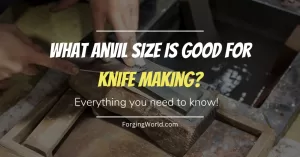As in any craft, safety comes first. Before you decide to make your first blacksmithing project, it is of crucial importance to know how to stay safe during work.
When it comes to safety, take it seriously, because having a heated iron near you can be extremely dangerous if not used properly. Now imagine you injured yourself. Just think about those lost days in which you could do the work you love, instead of resting. All because you didn’t take safety seriously.
For most of the blacksmithing work, your eyes and ears are first at the risk, so safety glasses and earplugs are just a few essentials of safety equipment. In order to prevent your arms while blacksmithing, it is desired to wear long shirts and pants, preferably made from cotton. Like a lot of small bits of material flying in the air, a respirator is very helpful to prevent the inhalation of these harmful particles.
We mentioned just a few of the safety equipment, but there are many more equipment and rules to keep in mind while working. To reduce the chances or even to avoid injuries during blacksmithing, it is necessary to take precautionary measures or as some may say; “Prevention is better than cure”.
What Safety Equipment Do I Need For Blacksmithing?
When it comes to blacksmithing, safety equipment is just as important as working tools. In case you are thinking you are not “a real man” just because you wear safety equipment and therefore, choose not to, you will eventually have a bad time. So let’s not be egoistic, but rather responsible about ourselves.
Typically, for blacksmithing safety, we would recommend you acquire:
- Safety Glasses
- Ear Protection
- Fire Extinguisher
- Gloves
- Cotton Clothing
- Respirator
SAFETY GLASSES
The first on our list is eye protection and for a very good reason. According to Prevent Blindness, the amount of people who injure their eyes at work is more than 2000. Every tenth injury will require at least 1 or a few days of recovery.
Many safety experts and doctors can tell you that 90% of these injuries can be prevented by wearing appropriate eye protection. This is where safety glasses come in (affiliate link).
Generally, safety glasses are divided into two categories: prescription and non-prescription (also called “Plano”) safety glasses. If you don’t require the prescription ones then you can easily find Plano type in your local store.
In case you need prescription safety glasses, you would have to buy them from a doctor or from some optical store with a written prescription by a licensed professional.
In regards to performance, safety glasses are classified into two types: basic impact and high impact.
The basic impact type is tested via a “drop ball” test where the small steel ball is dropped onto the lens from a height of approximately 1m. The lens should not chip or break during the test. They should be marked with “Z87” and their manufacturers’ trademarks. High impact is the type of safety glasses you are looking for. Since we are working with hot steel, we need to be extra safe to protect our eyes. The last thing you need is low-quality glasses.
In order to test high-impact glasses, a high-velocity test is performed. A tiny steel ball is shooted at the lens at a speed of 45 m/s (150 feet/s). The lens should not break or crack in order to pass the test.
Except for having properties of high impact, it is recommended for blacksmithing safety glasses to be made from polycarbonate.
Polycarbonate material protects our eyes from damaging UV light and is also very lightweight. A combination of characteristics like UV protection, comfort, and high impact resistance makes it an excellent choice for blacksmithing.
EAR PROTECTION
Blacksmithing is known to be very loud. According to British Columbia HealthLink, noise above 85 decibels are typically harmful to our hearing. Hammering the anvil is known to exceed noise levels far beyond this harmful point. Unless you want to develop severe hearing loss, you should definitely get good-quality ear protection.
You have 2 choices in regard to ear protection, earplugs, and earmuffs. Choosing between the two will depend on various factors, such as level of noise, comfort, and appropriateness.
EARPLUGS
Earplugs are simply stuck in the block of the ear canal. They can be either moldable or pre-molded.
Also, earplugs are generally cheaper than earmuffs. For some people, they are a more comfortable choice. It is important to note that they should be properly inserted as improper insertion can reduce noise protection. If you work in hot areas or indoors, earplugs are an excellent choice.
PROS of earplugs
- Simple to use
- Easy to carry
- Appropriate for hot working areas
- Easy to replace
- Cheaper than ear muffs
CONS of earplugs
- More difficult to insert and remove
- May cause irritation
- Requires a more demanding hygiene
- Inappropriate for people with ear infections and similar problems
EARMUFFS
The earmuffs look very similar to headphones. They consist of soft ear cushions and sound-reducing material. Altogether, earmuffs fit completely around the ears. They must be tightly constricted but still be comfortable enough to wear.
Earmuffs are easier to put on compared to earplugs. In case you are dealing with extremely high noise, these two can be worn together in order to reduce noise more efficiently (affiliate link).
PROS of earmuffs
- Generally, one size fits all
- Easier to put on and remove
- More durable
CONS of earmuffs
- Bigger and heavier
- More expensive
- Inconvenient for very hot areas
FIRE EXTINGUISHER
You don’t want to find yourself in a situation where the fire has started in a workshop and you don’t have anything to put out. To avoid that scenario, have at least a few gallons of water in the workshop. It would be even better to have a fire extinguisher, rather than water. As not every fire is the same, not every fire extinguisher is the same.
For example, a fire burst out of electrical components. Obviously, water, in that case, is not a great idea. That’s where carbon dioxide and dry chemical fire extinguisher comes in handy. So for a blacksmith, we would recommend having at least a few gallons of water and a dry chemical fire extinguisher.
However, if you are planning to use combustible metals such as magnesium, potassium, zirconium, sodium, sodium, and lithium, then a dry powder is an appropriate choice. For more detailed information on this topic, you can check on Fire Equipment Manufacturers’ Association.
GLOVES
Your hands are the most valuable tool and you should treat them that way. There is no blacksmithing without them. Gloves are another nice piece of safety equipment that is good to have.
They are also a hot topic in the blacksmithing industry as to whether should even wear them or not. Some blacksmiths will tell you that you should NEVER wear gloves and some will tell you that you should ALWAYS wear them. I think the best answer is somewhere in the middle.
Leather gloves are mostly used for blacksmithing purposes because of their strength and durability. Except for being a great insulator, leather is excellent heat-resistant.
So, Should I Wear Gloves In Blacksmithing Or Not?
It depends on the situation. If you are right-handed, the material is on your left hand while a hammer is on your right. Wearing gloves on the left hand can be beneficial as it will reduce radiating heat from hot metal. On the other hand, wearing a glove on the right hand will make it harder to hold and strike the hammer.
Iron doesn’t have to be red or orange in order to be hot, so it can trick you into grabbing it. You will most likely grab that iron with gloves rather than without them. Obviously. By the time you drop the hot steel on the floor, the heat is still on your glove, which can cause burns. There is also a high probability of having sweat under the glove, so the burn will become even worse.
Another situation where you SHOULD NOT wear gloves is near the machinery work. Let’s say that you are working at something like a drill press or lathe with gloves on. There is a high chance of snagging the finger at the edge of the cutter which can tear your skin and even your finger off. This is one of the biggest dangers of wearing gloves in a workshop.
However, you should wear gloves when working with punches or drifts. Your hand is near the radiating heat which comes from hot material. Wearing a glove in that situation will help a lot.
COTTON CLOTHING
I bet you didn’t see that coming. You may now wonder why is cotton clothing on the list. Let me explain.
Except for being a natural fiber and biodegradable, cotton is known for its advantages over synthetic clothing.
PROS of cotton clothing
- Breathable
- Hypoallergenic
- Natural
- Chemical-free
- Does not catch fire easily
The last advantage is the most relevant to any blacksmith. Namely, synthetic fibers are prone to catching fire easily and melting under the fire, which is not something any worker would like.
Therefore, wearing cotton is another safety measure you can take to reduce the likelihood of newly-formed burns. Although it is more expensive, I believe it is worth paying a couple of bucks more after knowing its advantages.
RESPIRATOR
Blacksmithing is known to be dusty and smokey. Because of that, it is necessary to protect our respiratory system from all dust and harmful chemicals. In case you have a dust mask and therefore, think that you don’t a respirator, we are hoping to change your mind.
First of all, a dust mask is not approved by NIOSH (National Institute for Occupational Safety and Health). Although dust masks and respirators look very similar, in regards to effectiveness, they are far from it.
Very often, a dusk mask does not have any information printed on them. A dust mask is actually made with the intention to prevent the spreading the wearer’s droplets into the environment.
They actually don’t protect you from harmful particles, so they should be worn where there is no dust and gases around.
Respirators actually provide 3 important benefits.
- Filters harmful particles from the air
- Purify the air
- Provides air supply
Knowing all of that, a respirator (affiliate link) is a no-brainer for respiratory system protection. But as with anything, there are some limitations. A respirator should be tightly sealed because if not, there is a big chance of inhaling contaminated air. It also comes in a variety of sizes and shapes.
And there you have, 6 essential pieces of safety equipment for every blacksmith. Stay safe and let’s get back to work.



